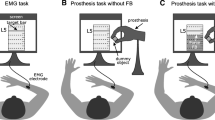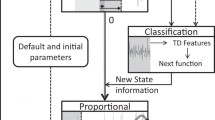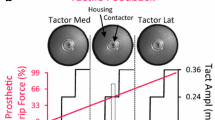Abstract
Prosthesis users usually agree that myoelectric prostheses should be equipped with somatosensory feedback. However, the exact role of feedback and potential benefits are still elusive. The current study investigates the nature of human control processes within a specific context of routine grasping. Although the latter includes a fast feedforward control of the grasping force, the assumption was that the feedback would still be useful; it would communicate the outcome of the grasping trial, which the subjects could use to learn an internal model of feedforward control. Nine able-bodied subjects produced repeatedly a desired level of grasping force using different control configurations: feedback versus no-feedback, virtual versus real prosthetic hand, and joystick versus myocontrol. The outcome measures were the median and dispersion of the relative force errors. The results demonstrated that the feedback was successful in limiting the variability of the routine grasping due to uncertainties in the system and/or the command interface. The internal models of feedforward control could be employed by the subjects to control the prosthesis without the loss of performance even after the force feedback was removed. The models were, however, unstable over time, especially with myocontrol. Overall, the study demonstrates that the prosthesis system can be learned by the subjects using feedback. The feedback is also essential to maintain the model, and it could be delivered intermittently. This approach has practical advantages, but the level to which this mechanism can be truly exploited in practice depends directly on the consistency of the prosthesis control interface.





Similar content being viewed by others
References
Antfolk C, D’Alonzo M, Rosén B et al (2013) Sensory feedback in upper limb prosthetics. Expert Rev Med Devices 10:45–54. doi:10.1586/erd.12.68
Augurelle A-S, Smith AM, Lejeune T, Thonnard J-L (2003) Importance of cutaneous feedback in maintaining a secure grip during manipulation of hand-held objects. J Neurophysiol 89:665–671. doi:10.1152/jn.00249.2002
Belter JT, Segil JL, Dollar AM, Weir RF (2013) Mechanical design and performance specifications of anthropomorphic prosthetic hands: a review. J Rehabil Res Dev 50:599–618
Chatterjee A, Chaubey P, Martin J, Thakor N (2008) Testing a prosthetic haptic feedback simulator with an interactive force matching task. JPO J Prosthet Orthot 20:27–34. doi:10.1097/01.JPO.0000311041.61628.be
Cipriani C, Zaccone F, Micera S, Carrozza MC (2008) On the shared control of an EMG-controlled prosthetic hand: analysis of user–prosthesis interaction. IEEE Trans Robot 24:170–184. doi:10.1109/TRO.2007.910708
D’Alonzo M, Dosen S, Cipriani C, Farina D (2013) HyVE: hybrid vibro-electrotactile stimulation for sensory feedback and substitution in rehabilitation. IEEE Trans Neural Syst Rehabil Eng. doi:10.1109/TNSRE.2013.2266482
Davidson PR, Wolpert DM (2005) Widespread access to predictive models in the motor system: a short review. J Neural Eng 2:S313–S319. doi:10.1088/1741-2560/2/3/S11
Dosen S, Markovic M, Hartmann C, Farina D (2014) Sensory feedback in prosthetics: a standardized test bench for closed-loop control. IEEE Trans Neural Syst Rehabil, Eng
Engeberg ED, Meek S (2008) Improved grasp force sensitivity for prosthetic hands through force-derivative feedback. IEEE Trans Biomed Eng 55:817–821. doi:10.1109/TBME.2007.912675
Engeberg ED, Meek SG, Minor MA (2008) Hybrid force-velocity sliding mode control of a prosthetic hand. IEEE Trans Biomed Eng 55:1572–1581. doi:10.1109/TBME.2007.914672
Haruno M, Wolpert DM, Kawato M (2001) Mosaic model for sensorimotor learning and control. Neural Comput 13:2201–2220. doi:10.1162/089976601750541778
Hermsdörfer J, Elias Z, Cole JD et al (2008) Preserved and impaired aspects of feed-forward grip force control after chronic somatosensory deafferentation. Neurorehabil Neural Repair 22:374–384. doi:10.1177/1545968307311103
Hermsdörfer J, Li Y, Randerath J et al (2011) Anticipatory scaling of grip forces when lifting objects of everyday life. Exp Brain Res 212:19–31. doi:10.1007/s00221-011-2695-y
Johansson RS, Cole KJ (1994) Grasp stability during manipulative actions. Can J Physiol Pharmacol 72:511–524
Jorgovanovic N, Dosen S, Djozic DJ et al (2014) Virtual grasping: closed-loop force control using electrotactile feedback. Comput Math Methods Med 2014:120357. doi:10.1155/2014/120357
Kaczmarek KA, Webster JG, Bach-y-Rita P, Tompkins WJ (1991) Electrotactile and vibrotactile displays for sensory substitution systems. IEEE Trans Biomed Eng 38:1–16. doi:10.1109/10.68204
Kawato M, Gomi H (1992) A computational model of four regions of the cerebellum based on feedback-error learning. Biol Cybern 68:95–103
Kawato M, Wolpert D (1998) Internal models for motor control. Novartis Found Symp 218:291 discussion 304–7
Kawato M, Furukawa K, Suzuki R (1987) A hierarchical neural-network model for control and learning of voluntary movement. Biol Cybern 57:169–185. doi:10.1007/BF00364149
Körding KP, Wolpert DM (2004) Bayesian integration in sensorimotor learning. Nature 427:244–247. doi:10.1038/nature02169
Lum PS, Black I, Holley RJ et al (2014) Internal models of upper limb prosthesis users when grasping and lifting a fragile object with their prosthetic limb. Exp Brain Res. doi:10.1007/s00221-014-4071-1
MacKenzie C, Iberall T (2010) The grasping hand. Elsevier B.V, Amsterdam
Metzger AJ, Dromerick AW, Schabowsky CN et al (2010) Feedforward control strategies of subjects with transradial amputation in planar reaching. J Rehabil Res Dev 47:201–211
Ning J, Dosen S, Muller K-R, Farina D (2012) Myoelectric control of artificial limbs—Is there a need to change focus? [In the Spotlight]. IEEE Signal Process Mag 29:150–152. doi:10.1109/MSP.2012.2203480
Ninu A, Dosen S, Muceli S et al (2014) Closed loop control of grasping with a myoelectric hand prosthesis: Which are the relevant feedback variables for force control? IEEE Trans Neural Syst Rehabil Eng. doi:10.1109/TNSRE.2014.2318431
Patterson PE, Katz JA (1992) Design and evaluation of a sensory feedback system that provides grasping pressure in a myoelectric hand. J Rehabil Res Dev 29:1–8
Sanger TD (2007) Bayesian filtering of myoelectric signals. J Neurophysiol 97:1839–1845. doi:10.1152/jn.00936.2006
Saunders I, Vijayakumar S (2011) The role of feed-forward and feedback processes for closed-loop prosthesis control. J Neuroeng Rehabil 8:60. doi:10.1186/1743-0003-8-60
Szeto AY, Saunders FA (1982) Electrocutaneous stimulation for sensory communication in rehabilitation engineering. IEEE Trans Biomed Eng 29:300–308
Weeks DL, Wallace SA, Noteboom JT (2000) Precision-grip force changes in the anatomical and prosthetic limb during predictable load increases. Exp Brain Res 132:404–410
Wolpert DM, Kawato M (1998) Multiple paired forward and inverse models for motor control. Neural Netw 11:1317–1329
Wolpert DM, Miall RC (1996) Forward models for physiological motor control. Neural Netw 9:1265–1279
Acknowledgments
This work is financially supported by the German Ministry for Education and Research (BMBF) via the Bernstein Focus Neurotechnology (BFNT) Göttingen under the Grant Nos. 01GQ0817 and 01GQ0810, and the European Commission under the MYOSENS (FP7-PEOPLE-2011-IAPP-286208) projects.
Author information
Authors and Affiliations
Corresponding author
Rights and permissions
About this article
Cite this article
Dosen, S., Markovic, M., Wille, N. et al. Building an internal model of a myoelectric prosthesis via closed-loop control for consistent and routine grasping. Exp Brain Res 233, 1855–1865 (2015). https://doi.org/10.1007/s00221-015-4257-1
Received:
Accepted:
Published:
Issue Date:
DOI: https://doi.org/10.1007/s00221-015-4257-1




